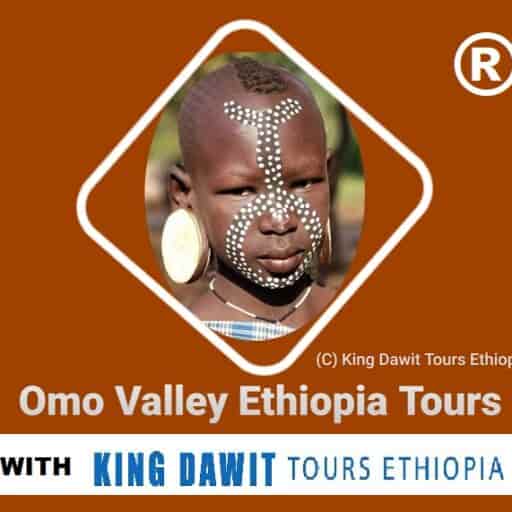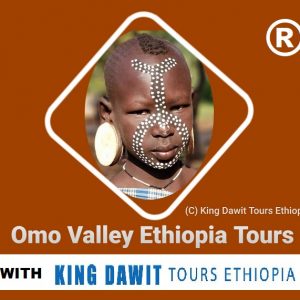About Omo Valley Ethiopia
About Omo Valley Ethiopia:
Due to the cultural diversity of more than a dozen tribes that coexist in varying degrees of peace, the Lower Omo Valley Ethiopia is one of the most fascinating tourist sites in Ethiopia and even on the continent of Africa.
One of their most valuable resources, the Omo River, supplies most of the dry savanna expanse that makes up the valley. Numerous small tribal villages dot the landscape along the river and throughout the valley, each of which has its own distinct customs and language.
Since the discovery of prehistoric human remains dating back nearly 2.5 million years, the Lower Omo Valley Ethiopia region has been designated as a Unesco World Heritage site. These tribes have lived here for centuries.
The Omo Valley Ethiopia Tribes
Mursi Tribe of Ethiopia
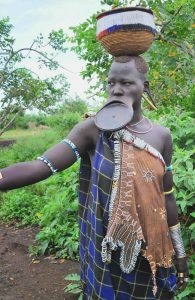 With a population of around 8,000 people, the Mursi is one of the more well-known tribes of the Omo Valley. They are described as a traditionally migratory community, but in reality, they only move from the Omo’s banks to the grasslands during the rainy season.
With a population of around 8,000 people, the Mursi is one of the more well-known tribes of the Omo Valley. They are described as a traditionally migratory community, but in reality, they only move from the Omo’s banks to the grasslands during the rainy season.
The Mursi place a high value on cattle, with the exchange of which most relationships, such as marriage, are marked, and their diets are also based on cattle.
They speak Surmic, a language of the Nilo-Saharan language family. Their history is preserved through a rich oral storytelling tradition.
Mursi women are distinguished by the wearing of ornamental clay disks (Debhinya) on their bottom lips as symbols of beauty and adulthood. When a girl is in her early adolescence, her bottom lip is cut and the clay disk is used to keep it open until it heals. This cut is then gradually stretched over several months by inserting slightly larger clay disks each time, with each woman deciding how far to stretch her lip.
The Mursi tribe is also known for its ceremonial dueling. Teams of men from the population fight with 2-meter wooden poles (donga) until one man fall to the ground or has to retreat due to injury. These competitions typically last for several days and are taken very seriously. The women engage in a ritualized duel in which they strike each other with iron bracelets called Ula. According to legend, the Ula is a representation of strength, and only the strongest women are deserving of donning it.
Bodi Tribe Ethiopia
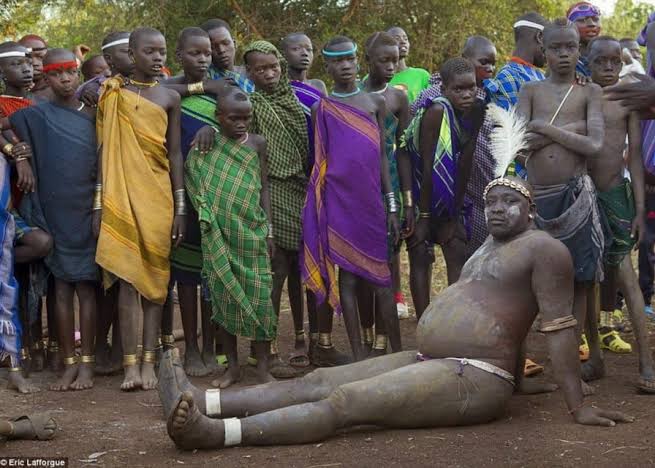 The Bodi and Mursi tribes are neighbors and frequently conduct transactions together. They are pastoralists who prioritize cattle and rarely engage in agricultural activities, preferring to trade for maize and other agricultural commodities at tribal markets instead. They are nomadic communities that move to avoid the land being depleted and to give their cattle new grazing grounds.
The Bodi and Mursi tribes are neighbors and frequently conduct transactions together. They are pastoralists who prioritize cattle and rarely engage in agricultural activities, preferring to trade for maize and other agricultural commodities at tribal markets instead. They are nomadic communities that move to avoid the land being depleted and to give their cattle new grazing grounds.
The Bodi’s primary diet is also centered on cattle because of how important cattle are to their way of life. They specifically drink their own milk mixed with their own blood, which they obtain by making a neck wound in the animal rather than killing it.
While women wear clothing made of goat skin, Bodi men wear skirts made of fabric. The scarification ritual, which is performed by both men and women, is used to highlight the courage and beauty of individuals.
The Bodi people have a remarkably unusual custom known as The Holiday of the Fat Men (Ka’el). On the day of the ceremony, each competing man is covered in clay and ash before walking around a sacred tree in front of all the members of the local community. After selecting the fattest man, a cow is slaughtered, and the man is rewarded with fame and hero status. Fat is considered very attractive in this tribe, so women use this ceremony to find potential husbands.
Hamer Tribe Ethiopia
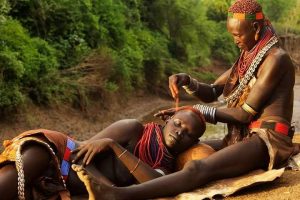 The Hamer is one of Ethiopia’s most traditional and ancestral villages. They are an African ethnic group who live in the country’s south, east of the Omo River, near the Kenyan border.
The Hamer is one of Ethiopia’s most traditional and ancestral villages. They are an African ethnic group who live in the country’s south, east of the Omo River, near the Kenyan border.
They survive on agriculture and pastoralism, but they have also added another activity that provides them with not only economic but also cultural and social wealth: markets.
Markets have evolved into one of the Hamer tribe’s primary social gathering places. Everyone gathers there to barter or sell native products such as vegetables, spices, fabrics, coffee, tobacco, pumpkins, tools, and other Ethiopian tribe characteristics.
The women of the Hamer tribe wear ocher mud-impregnated hair with braids, usually in feather-adorned hairstyles. The large necklaces and stripes made of seashells are, without a doubt, the most distinguishing features of their clothing. As a result, ornaments differentiate a married woman from a single woman.
Daasanach Tribe
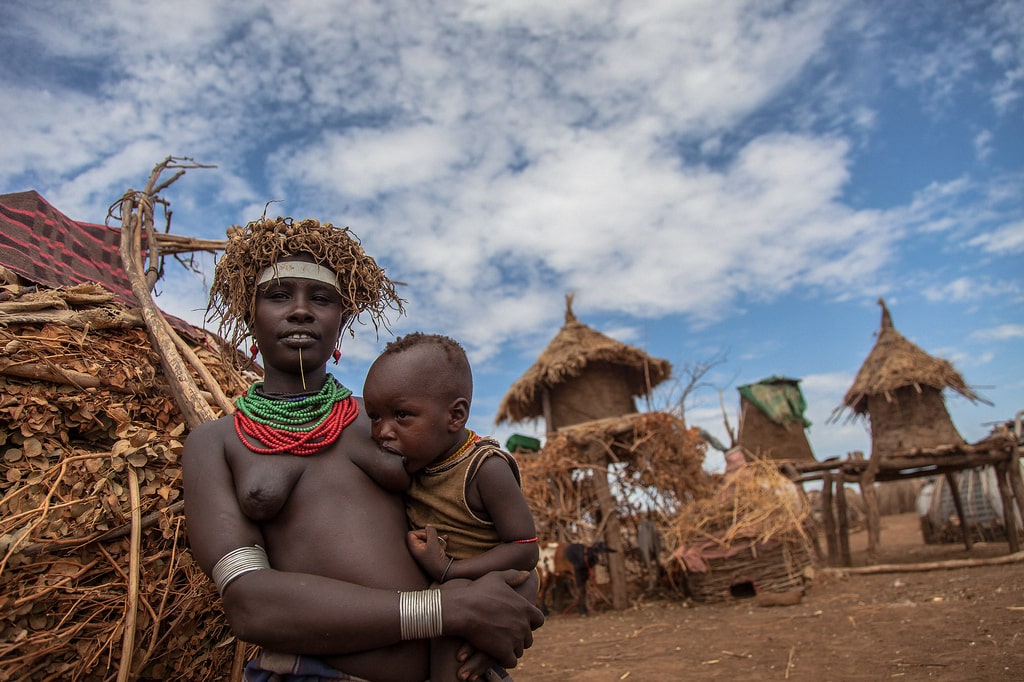 There are about 20,000 members of the Daasanach tribes, which are located in the southernmost section of the Omo Valley. They actually go by the term “People of the Delta” since they reside where the Omo River delta meets Lake Turkana. They are predominantly pastoralists who raise maize, beans, and pumpkins during the flooded seasons of the delta. They depend on their cattle and goats for milk, meat, and hides during dry seasons. They speak a distinct language and live in dome-shaped dwellings built of branches covered in hides, and the floors are covered with mats.
There are about 20,000 members of the Daasanach tribes, which are located in the southernmost section of the Omo Valley. They actually go by the term “People of the Delta” since they reside where the Omo River delta meets Lake Turkana. They are predominantly pastoralists who raise maize, beans, and pumpkins during the flooded seasons of the delta. They depend on their cattle and goats for milk, meat, and hides during dry seasons. They speak a distinct language and live in dome-shaped dwellings built of branches covered in hides, and the floors are covered with mats.
The lower class of the tribe is known as the Dies, and they are the individuals who have lost their cattle and thus their means of subsistence. Rather than living with the rest of the tribe, they live near Lake Turkana and hunt crocodiles for food.
The Daasanach have created a truly unique method of creating jewelry out of items such as SIM cards, old digital watches, and bottle caps. In fact, their bottle cap headdresses are instantly recognizable. Men wear a cloth around their waist, while women wear pleated cow skin skirts with numerous bracelets and necklaces.
Karo Tribe Ethiopia (Caro)
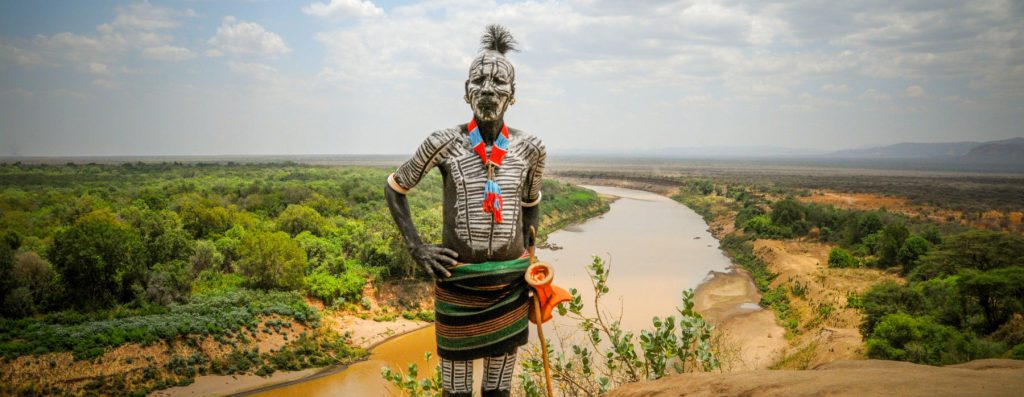
The Karo tribe is the smallest tribe in South Ethiopia, living along the Omo River’s banks. Surrounded by more powerful and wealthy tribes, there is a complex social hierarchy in place to prevent intermarriage and preserve their lineages.
They are distinguished by practices that are unique to them, just like many original tribes. One of the most striking characteristics of this tribal culture is the desire to adorn themselves with bright colors.
The Karo is unquestionably artistic. They are known for their alluring and intricate body and face painting, in addition to farming and livestock. They use white chalk and natural minerals, such as red ochre, to decorate their faces and bodies.
Arbore Tribe

In contrast, Arbore is significantly more rural and unaffected than many other similarly sized towns in South Omo. The Arbore moved to their current homeland from Konso perhaps two centuries ago, sharing linguistic and cultural similarities with their Tsemai neighbors. The Arbore historically played a significant role as middlemen in trade between the Omo River and the Konso Highlands due to their ancestry and cultural connections to Konso and the pastoralists of the nearby lowlands.
The town of Arbore is situated in a region that is divided into several tribal areas. It also has a sizable population of Hamer and even Borena women because the Arbore people frequently intermarry with other ethnic groups, giving it a more cosmopolitan feel.
The Nyangatom, Bume peoples
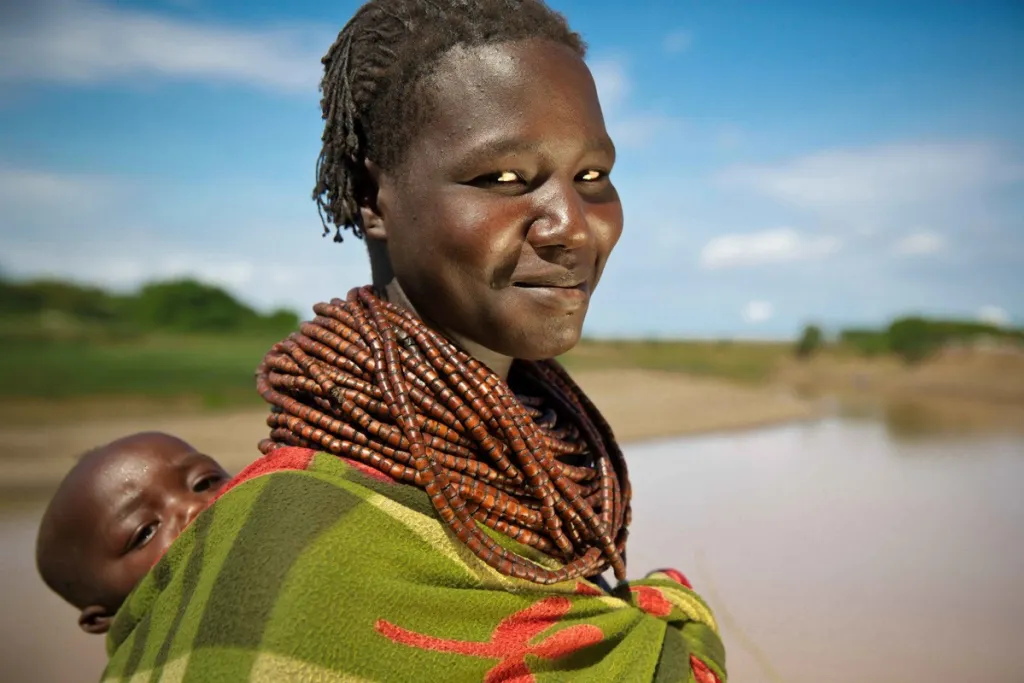 The Nyangatom, also known as Bume, inhabit the south of Omo National Park and occasionally move into the park’s lower parts when water or grazing is insufficient. The Bumi has a population of 6,000-7,000 people. They are agro-pastoralists who rely on livestock herding and floor-retreat agriculture (consisting mainly of sorghum harvesting on the Omo and Kibish Rivers). The Bumi enjoy honey and frequently smoke out beehives in the park to get the honey from within the nests.
The Nyangatom, also known as Bume, inhabit the south of Omo National Park and occasionally move into the park’s lower parts when water or grazing is insufficient. The Bumi has a population of 6,000-7,000 people. They are agro-pastoralists who rely on livestock herding and floor-retreat agriculture (consisting mainly of sorghum harvesting on the Omo and Kibish Rivers). The Bumi enjoy honey and frequently smoke out beehives in the park to get the honey from within the nests.
The Bumi is well-known for being great warriors and, on occasion, aggressive warmongers. They frequently clash with neighboring tribes, including the Hamer, Karo, and Surma.
Small communities of Bumi living near the Omo River are skilled crocodile hunters who use dugout canoes and harpoons. The elderly of both sexes wear a lower lip plug, which is fashioned of ivory for males and copper filigree for women.
Tsemai ( Tsemay People)
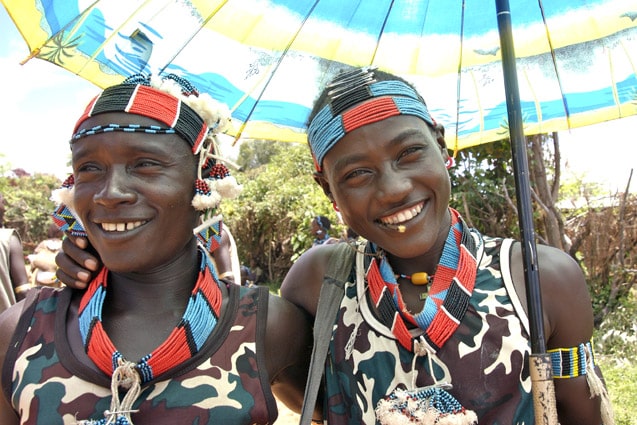
The Tsemai, the majority of inhabitants of Weito village on the Konso-Jinka road, is considered one of Ethiopia’s least known ethnic groups. They are estimated to number around 5000 people. Their territory stretches along the Weito River’s western bank, also known as the Dulaika River in Tsemai. They are mixed subsistence farmers who employ flood agriculture, with sorghum and maize as key crops. They also raise livestock, particularly cattle, and cultivate beehives for honey production.
The Tsemai speak an Omotic language with influences from the Eastern Cushitic language, which is closely connected to the one spoken in Konso, where their founding chief, Asasa, is said to have originated. The current chief, who lives in Ganda Bogolkila, the long-standing Tsemai capital, is said to be the ninth in line after Asasa, implying that the migration took place between 150 and 250 years ago.
Market days in the Omo Valley Ethiopia
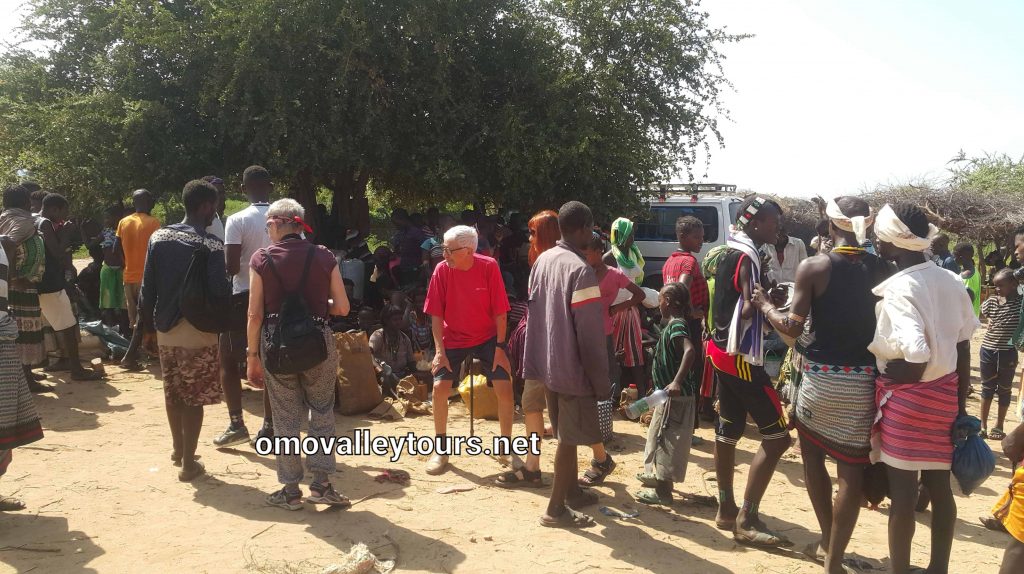
Market towns provide the best possibilities for meeting local tribal people as they go about their trade and business. The villages are ideal places to observe traditional ceremonies and obtain a deeper understanding of the many cultures and ways of life.
- Thursday at Key Afer for Benna, Hammer, Erbore, and Tsemai
- Dimeka on Saturday For Bena, Hammer, Karo, and sometimes Gallabs
- Monday at Turmi for Hammer and Karo
- Monday at Konso city for Konso and Derashi People






